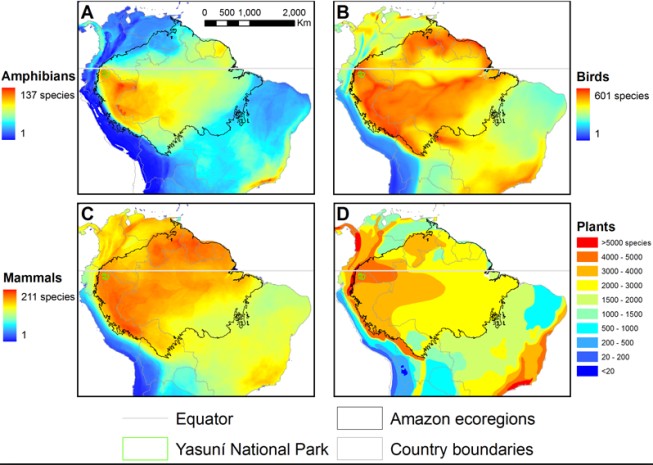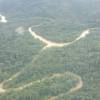Ecuador Internacional
Developments in the Ecuadorian ITT Initiative and Yasuní National Park: Balancing the Protection of the Environment and Native Rights
Northeastern University Law Journal 30/12/2014

Fuente: New Security Beat
Matt Finer, a scientist at the Center for International Environmental Law in the United States, expressed his view on the situation surrounding Yasuní National Forest in Ecuador: “Now there is really no viable alternative to stop the wave of drilling slated for the most biodiverse region of the world.”[1] It is true the number of ways to save Yasuní may be shrinking, but they have not yet disappeared.
I. Yasuní National Forest
Yasuní National Forest (Yasuní) is arguably the most biodiverse place on the planet.[2] One hectare of rain forest contains more species of tree than in the United States and Canada combined.[3] Yasuní is in the north corner of Ecuador and was designated a Biosphere Reserve by the United Nations Education, Scientific, and Cultural Organization (UNESCO) in 1989.[4] This section of rainforest is an important center of biodiversity.[5]
Along with its immense and awe-inspiring ecological wonders, Yasuní is also home to the Waorani—an indigenous group.[6] Although the numbers cannot be validated, it is believed that approximately 3,000 Waorani live in Yasuní with about 100 choosing to remain in voluntary isolation from the modernizing world outside Yasuní’s borders.[7] The subsections of the tribe still living in voluntary isolation are referred to as the Taromenane.[8]
II. Oil Underneath
Below Yasuní lies a large oil deposit, containing an estimated 20 percent of Ecuador’s oil reserves.[9] Ecuador produces about 500,000 barrels of crude oil each day.[10] Pipelines spider through the Ecuadorian Amazon, transporting oil from South America’s third-largest reserves for sale in other nations. [11] Environmental and cultural impacts of Ecuador’s resource exploitation have been far from minimal. Texaco, an oil company that has since merged with Chevron, started drilling in Ecuador in the 1970s.[12] Estimated in 1989, each day approximately 3.2 million gallons of wastewater—and over 19 million gallons of crude oil in total—have been dumped into the environment during Texaco’s operations in Ecuador.[13]
Ecuador’s energy consumption has doubled in the past decade,[14] and the amount of oil under Yasuní is estimated to be worth over $7 billion.[15] Given the severity of past environmental damage, Ecuador has not easily relinquished Yasuní to future ecological destruction. In 2007, Ecuadorian President Rafeal Correa signed the Ishpingo-Tambococha-Tiputini Initiative (ITT Initiative).[16] The area of the Yasuní known as the ITT block is one of many in Ecuador's concession system for oil extraction.
The ITT Initiative created a trust fund administered by the United Nations in which countries would donate money or pledge donations to preserve Yasuní.[17] The ITT Initiative’s goal was to accumulate $3.6 billion by 2023, approximately half the initial estimated worth of Yasuní’s oil reserve.[18] The donations would be used to protect biodiversity and mitigate climate change[19]—drilling in Yasuní would release approximately 410 million metric tons of carbon dioxide into the atmosphere.[20] Funds would be divided between environmental and developmental objectives by a steering committee.[21] Two representatives of this six-person steering committee would come from “donor governments” in order to ensure that the donations would actually fund an environmental objective.[22] However, the Ecuadorian chairperson has the authority to approve decisions if the committee could not reach an agreement.[23]
The ITT Initiative was seen as “setting a precedent in the fight against global warming by lowering the high cost to poor countries of preserving the environment.”[24] Others mocked the ITT Initiative “as attempted blackmail, or as Ecuador holding itself hostage for ransom.”[25] However, by August 2013, the fund held only $13 million in donations.[26] Germany rescinded a $50 million commitment in June 2011; after that, progress stalled.[27] Less than seven years after announcing the ITT Initiative, in August 2013, President Correa declared that the world “failed” Ecuador and he blamed the world’s nations for failing to take responsibility and help conserve a goldmine of biodiversity.[28]
Some cite Ecuador’s allegedly corrupt government and ambiguity in how funds would be spent as the major culprits in this failure.[29] Government documents indicate that, while the ITT Initiative was still active, Ecuador was negotiating a secret deal with China to drill in Yasuní in exchange for funding other Ecuadorian projects.[30] Ecuador is also litigating a RICO case[31] surrounding the allegedly corrupt Chevron ruling that would have enforced a transfer of $19 billion in damages to Ecuador for the ecological destruction from Texaco’s pollution.[32] Given Ecuador’s questionable past, nations may have been reluctant to trust the ITT Initiative’s procedures, which may have curbed donations.
III. The Ecuadorian Constitution and Proposed Systems to Protect the Rights of Pachamama
In 2008, Ecuador became the first country to amend its Constitution to include the rights of nature.[33] Mother Nature, or Pachamama, “has the right to integral respect for its existence and for the maintenance and regeneration of its life cycles, structure, functions and evolutionary processes,”[34] including the right to restoration.[35] Any Ecuadorian citizen can call upon public authorities to enforce the rights of nature.[36] However, as promising as the amended Constitution seems, there are many issues in its implementation.
a. The Lack of Enforcement of the Constitution by the Executive Branch
For example, to enforce the amendments, the executive authority must intend to implement them, and it remains unclear whether President Correa is willing to do so in any context.[37] What creates further uncertainty is Ecuador’s recent high turnover of executive power.[38] Elected in 2007, President Correa is Ecuador’s eighth president since 1996.[39] Changing political climates have resulted in a wide range of constitutional amendments.[40] This suggests that, if the high rate of political and executive turnover continues, the existence of these amendments is not guaranteed.[41]
b. The Lack of Standing for Private Plaintiffs
Ecuador’s standing doctrine also acts as a barrier to enforcing these amendments. Normally, to claim a constitutional violation, a citizen of Ecuador would file an acción de amparo.[42] However, Ecuador’s standing doctrine mirrors the United States’ requirement that plaintiffs suffer an injury before sustaining a cause of action.[43] These amendments grant nature the right to exist. If this right is violated, under the current standard for acción de amparo, a citizen may not have standing to bring nature’s claim because nature is the injured party, not the citizen.[44] This also creates a procedural barrier because plaintiffs claiming these rights for nature do not yet know the proper standing requirements.[45]
Many countries have expanded their standing doctrine increasing the likelihood of success of environmental litigation.[46] However, this expansion has been focused on redefining the “injury” requirement resulting in an “incoherent” interpretation of environmental protection statutes.[47] By still requiring plaintiffs to show injury to themselves and not to the environment, Ecuador’s standing doctrine perpetuates depreciation of ecology within environmental jurisprudence.[48] This doctrine seems illogical when constitutional provisions specifically enacted to protect the environment cannot be enforced in the courts.
For the Ecuadorian constitutional amendments to truly allow citizens to sue for the rights of nature, acción de amparo must be expanded to allow injury to the environment to trigger adequate standing. Or, like the Supreme Court of the Philippines, Ecuador could implement a Writ of Nature, creating the procedural structure necessary to enforce environmental statutes.[49]
Moreover, Ecuador could establish a court that specifically addresses environmental cases. Environmental courts have become a recent global trend in response to a heightened sense of environmental legal interests.[50] Currently, over 350 environmental courts and tribunals exist in approximately 40 countries.[51] These courts foster international respect for environmental law,[52] and if implemented in Ecuador, can promote consistent environmental jurisprudence. The judges of these courts are educated in environmental science and work to incorporate science into their decisions.[53] Scientifically literate jurisprudence ensures that inapplicable precedent does not stifle the development of modern environmental law.[54]
c. Outside Influences on the Judiciary
Unfortunately, even if Ecuador finds a solution to its standing doctrine dilemma, the Ecuadorian judiciary is another obstacle to citizens claiming rights for nature. The Ecuadorian Court, known as the Tribunal Constituciónal, is entangled in controversies between the executive and legislative branches, where political relationships likely influence the Court’s decision-making.[55] The Constitution effectively allows President Correa to bypass nature’s rights if the National Assembly declares the extraction of resources a national interest.[56]
Furthermore, concerning protections provided to indigenous peoples, the Constitution expressly states that “the territories of the peoples living in voluntary isolation are an irreducible and intangible ancestral possession and all forms of extractive activities shall be forbidden there.”[57] This provision seems to protect Yasuní, not because of its ecological well-being, but because the Taromenane live in voluntary isolation within the ITT block.[58] To authorize the drilling project, “the government redrew maps of tribal territory, claiming that the Taromenane and smaller Tagaeri clans didn’t live in the oil-rich areas after all.”[59] Thus, the Tribunal Constituciónal could not assess the damage to the native people of the Yasuní because the ITT block did not technically violate the Constitution.
IV. The Current Situation
President Correa recently opened up Yasuní to potential drilling after announcing the ITT Initiative’s failure, claiming less than one percent of Yasuní land will be seriously affected.[60] Estimates show that drilling will actually affect 20 to 30 percent of Yasuní.[61] New studies highlight the sensitivity of this ecosystem and suggest that even the most minimal of roads can negatively affect species’ abundance.[62] Recent polls show that 78 to 90 percent of Ecuadorians are opposed to drilling.[63] After President Correa announced the ITT Initiative’s failure, a historic march was led in its protest; the protest leaders included members of deep Amazonian tribes.[64]
The most promising solution lies with the Ecuadorian people. The Constitution allows citizens of Ecuador to vote by national referendum if they gather signatures from 5 percent of the nation’s citizens (currently 500,000 would be necessary).[65] After President Correa’s announcement, approximately 850,000 signatures were gathered;[66] this number of signatures should have led to a national vote.[67] However, after analyzing the admitted signatures, only 359,762 were deemed genuine.[68] Signatures were discarded for illegibility, incorrect ink color, and repetition.[69] The group collecting signatures, the Yasunidos, accused the Ecuadorian government of fraud.[70] Some have requested that the government publish the inauthentic signatures and allow citizens of those signatures to come forth and fix any problems.[71] After the proposed referendum’s failure, permits to drill were granted and drilling has already begun.[72] Preparation for drilling, including the construction of roads, will begin sooner.[73]
In March 2013,[74] before the ITT Initiative’s failure, members of the Taromenane tribe killed two Waorani elders.[75] The Waorani retaliated by massacring twenty Taromenane, a large number given the Taromenane population totals under two hundred.[76] Drilling in Yasuní will further push the Waorani and the Taromenane into one another’s territory, which will inevitably result in violence and possible elimination of these Amazonian tribes. Moreover, these indigenous inhabitants of the land must suffer the impacts of the enclosing outside world.
V. Conclusion
The fate of Yasuní is in the hands of Ecuadorian citizens. Implementing a new writ or standing doctrine for environmental rights, or additional courts that address environmental adjudication, will aid in protecting Ecuadorian ecosystems in the future. However, Yasuní may not survive that long. If Yasuní is to be saved, time is of the essence.
----------------------------------------------------------------------------------------------------------------------
* Candidate for Juris Doctor, 2016, Northeastern University School of Law.
[1] Gonzalo Solano, Ecuador to Drill for Oil in Amazon Rainforest After Rich Countries Failed to Pay Up, Financial Post (Aug. 16, 2013), http://business.financialpost.com/2013/08/16/ecuador-to-drill-for-oil-in....
[2] Kelly Swing, Oil Vote Deadline Looms for Ecuador’s Yasuní National Park, Environment News Service (April 8, 2014), http://ens-newswire.com/2014/04/08/oil-vote-deadline-looms-for-ecuadors-....
[3] The Yasuní National Park’s Biodiversity, Yasuní-Two Seconds of Life, http://yasunimovie.wordpress.com/yasuni-itt-initiative/the-yasuni-nation... (last visited Sep. 26, 2014).
[4] UNESCO – MAB Biosphere Reserves Directory, Yasuní, http://www.unesco.org/mabdb/br/brdir/directory/biores.asp?mode=all&code=... (last updated Jan. 12, 2011).
[5] Within this 2.4 million acres of the Amazon River Basin live 200 species of mammal, 300 species of reptile, and almost 600 species of bird. These numbers increase exponentially when the multitude of insect species crawling, hopping, and flying amongst the forest are added. Margot S. Bass et al., Global Conservation Significance of Ecuador's Yasuní National Park, Plos One (Jan. 19, 2010), http://www.plosone.org/article/info%3Adoi%2F10.1371%2Fjournal.pone.0008767.
[6] Kelly Swing, Oil Development on Traditional Lands of Indigenous Peoples, 28 J. Dev. Societies 257, 259 (2012).
[7] Id.
[8] See Bethany Horne, After All the People We Killed, We Felt Dizzy, Newsweek (Jan. 16, 2014), http://www.newsweek.com/after-all-people-we-killed-we-felt-dizzy-225424.
[9] Solano, supra note 1.
[10] Nick Miroff, In Ecuador, Oil Boom Creates Tension, Wash. Post (Feb. 17, 2014), http://www.washingtonpost.com/world/in-ecuador-oil-boom-creates-tension/....
[11] Id.
[12] Judith Kimerling, Lessons from the Chevron Ecuador Litigation: The Proposed Intervenors’ Perspective, 1 Stan. J. Complex Litig. 241, 242 n.2, 262 (2013).
[13] Id. at 243.
[14] Miroff, supra note 10.
[15] See Esme McAvoy, Oil or Life? Ecuador's Stark Choice, New Internationalist, Apr. 1, 2011, available at http://newint.org/features/2011/04/01/yasuni/ (estimating the amount at over $7 billion).
[16] Kelly Swing, Day of Reckoning for Ecuador’s Biodiversity, 469 Nature 267, 267 (2011).
[17] Joshua M. Alter, The Responsibility to Preserve: A Road Map for Saving Ecuador’s Yasuni Rain Forest, 26 N.Y. Int’l L. Rev. 53, 55 (2013).
[18] Joe Gurowsky, Ecuador Reverses Course, Foreign Policy Blogs Network (Aug. 20, 2013), http://foreignpolicyblogs.com/2013/08/20/ecuador-reverses-course/.
[19] Ryan Haddad, An Un-conventional Approach: Ecuador’s Yasuni-ITT Initiative is in Discord with the UNFCCC, 12 Sustainable Dev. L. & Pol’y 15, 15 (2012).
[20] Ecuador: Behind Correa’s Rainforest Drilling Decision, Energy Compass (Aug. 30, 2013), http://www.energyintel.com/pages/login.aspx?fid=art&DocId=819620.
[21] Thomas M. Gremillion, Reducing Carbon Emissions Through Compensated Moratoria: Ecuador’s Yasuni Initiative and Beyond, 41 ELR 10641, 10646 (2011).
[22] Id.
[23] Multi-Partner Trust Fund Office, U.N. Dev. Grp., About: Governance, Yasuni-ITT Initiative Trust Fund (Sep. 26, 2014), http://yasuni-itt.gob.ec/espanol/trust-fund-terms-of-reference/.
[24] Solano, supra note 1.
[25] Horne, supra note 6.
[26] Gurowsky, supra note 18.
[27] Rhett Butler, Ecuador Shelves Big Idea for Saving the Amazon, Mongabay News (Aug. 16, 2013), http://news.mongabay.com/2013/0816-yasuni-dead.html.
[28] Solano, supra note 1.
[29] See David Hill, Ecuador Pursued China Oil Deal While Pledging to Protect Yasuni, Papers Show, The Guardian, Feb. 19, 2014, http://www.theguardian.com/environment/2014/feb/19/ecuador-oil-china-yasuni.
[30] Id.
[31] Id.
[32] Judith Kimerling, supra note 12, at 245.
[33] Mary Elizabeth Whittemore, The Problem of Enforcing Nature’s Rights Under Ecuador’s Constitution: Why the 2008 Environmental Amendments Have No Bite, 20 Pac. Rim L. & Pol’y J. 659, 659-60 (2011).
[34] Constitutión Politica de la República del Ecuador, art. LXXI, available at http://pdba.georgetown.edu/Constitutions/Ecuador/english08.html [hereinafter Const.].
[35] Const. art. LXXII.
[36] Const. art. LXXI.
[37] See Whittemore, supra note 33, at 662-65.
[38] See Daniel Schweimler, Ecuador: New Hopes and Challenges, BBC News (Apr. 16, 2007), http://news.bbc.co.uk/2/hi/americas/6561961.stm; Simon Romero, Ecuador Vote: Leader Forges Middle Road Among Leftists, N.Y. Times (Nov. 28, 2006), http://query.nytimes.com/gst/fullpage.html?res=9A04E4D7103EF93BA15752C1A....
[39] See Whittemore, supra note 33, at 661.
[40] Id. at 662.
[41] Id.
[42] Id. at 667.
[43] See Allan R. Brewer-Carias, Constitutional Protection of Human Rights in Latin America: A Comparative Study of Amparo Proceedings, 181 (2009).
[44] Whittemore, supra note 33, at 667.
[45] Id. at 666-68.
[46] See Josh Gellers, Righting Environmental Wrongs: Assessing the Role of Legal Systems in Redressing Environmental Grievances, 26 J. Envtl. L. & Litig. 461, 462 (2011).
[47] See David N. Cassuto, The Law of Words: Standing, Environment, and Other Contested Terms, 28 Harv. Envtl. L. Rev. 79, 80 (2004).
[48] See id.
[49] Nicholas A. Robinson, Ensuring Access to Justice Through Environmental Courts, 29 Pace Envtl. L. Rev. 363, 387 (2012).
[50] See id. at 387 n.32.
[51] Id. at 373.
[52] See id. at 380.
[53] Id. at 379.
[54] Id.
[55] Whittemore, supra note 33, at 674.
[56] Const. art. CDXVII.
[57] Const. art. LVII.
[58] Miroff, supra note 10.
[59] Id.
[60] Gurowsky, supra note 18.
[61] Id.
[62] Jeremy Hance, High-Living Frogs Hurt by Remote Oil Roads in the Amazon, Mongabay News (Jan. 14, 2014), http://news.mongabay.com/2014/0114-hance-canopy-frogs-oil.html.
[63] Gurowsky, supra note 18.
[64] Horne, supra note 8.
[65] Jeremy Hance, Yasuni Could Still Be Spared Oil Drilling, Mongabay News (Aug. 26, 2013), http://news.mongabay.com/2013/0826-hance-yasuni-take-two.html.
[66] Adam Vaughan, Ecuador Signs Permits for Oil Drilling in Amazon’s Yasuni National Park, The Guardian (May 23, 2014), http://www.theguardian.com/environment/2014/may/23/ecuador-amazon-yasuni....
[67] Hance, supra note 65.
[68] Vaughan, supra note 66.
[69] Arturo Villavicencio et al., Consulta Yasuní: Informe de la Comisión Mixta de Alto Nivel, La Línea de Fuego (May 2, 2014), http://lalineadefuego.info/2014/05/02/consulta-yasuni-informe-de-la-comi...
[70] Vaughan, supra note 66.
[71] Villavicencio et al., supra note 66.
[72] Vaughan, supra note 69.
[73] Id.
[74] Horne, supra note 8.
[75] Miroff, supra note 10.
[76] See Swing, supra note 6, at 259; Horne, supra note 8.
Fuente OriginalNotas relacionadas
-
 ConocoPhillips Subsidiary Can Enforce $380M Ecuador Award
ConocoPhillips Subsidiary Can Enforce $380M Ecuador Award -
 Analysis: Liberal Media Lionize Anti-Chevron Lawyer Steve Donziger
Analysis: Liberal Media Lionize Anti-Chevron Lawyer Steve Donziger -
 Análisis: Medios de comunicación izquierdistas convierten en mártir al corrupto abogado anti-Chevron, Steven Donziger
Análisis: Medios de comunicación izquierdistas convierten en mártir al corrupto abogado anti-Chevron, Steven Donziger -
 New conservation area established in the Ecuadorian Amazon Pastaza region
New conservation area established in the Ecuadorian Amazon Pastaza region -
 Ecuador’s Shrinking Democracy
Ecuador’s Shrinking Democracy -
 Se expone el chantaje contra Chevron
Se expone el chantaje contra Chevron
